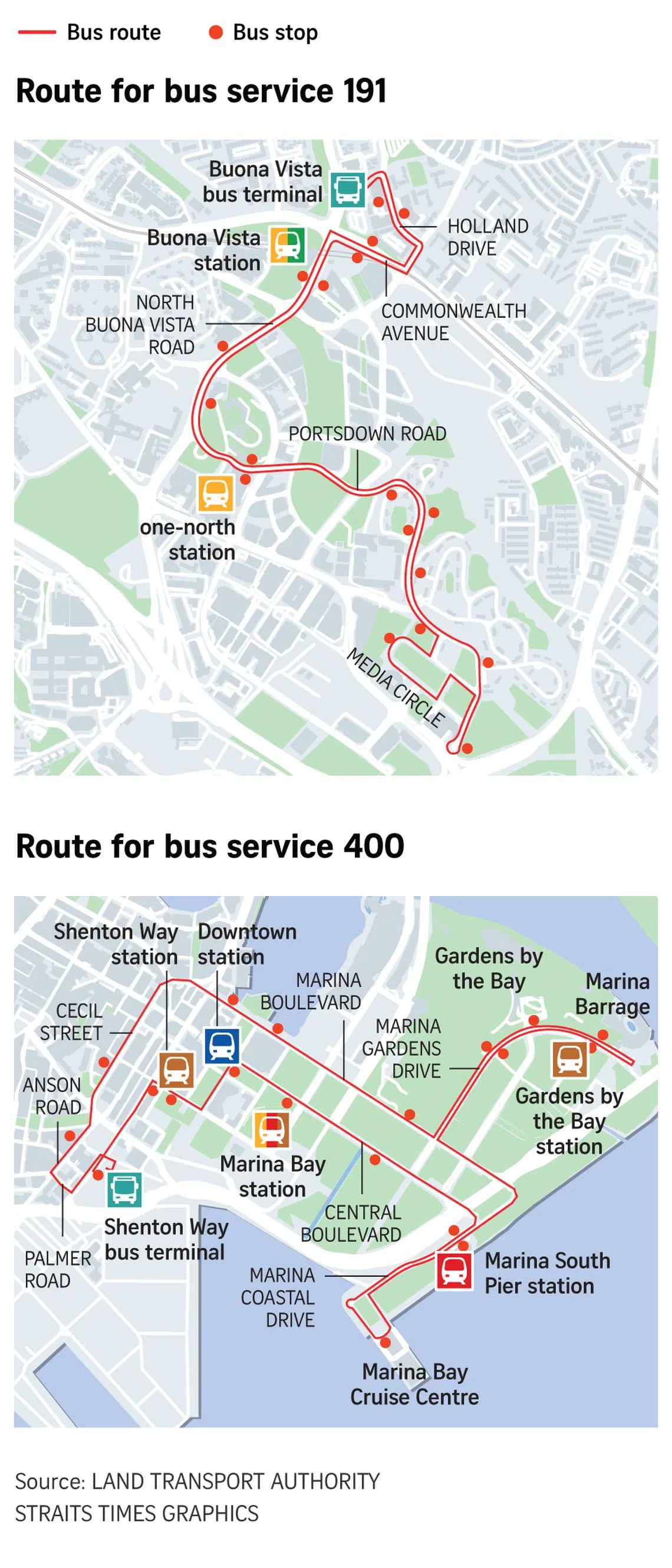Self-driving public buses to be tested from mid-2026 on service 191 and 400 as part of trial
Sign up now: Get ST's newsletters delivered to your inbox

LTA launched a tender seeking proposals for plans on operating autonomous public buses on Jan 27.
PHOTO: LTA/FACEBOOK
Follow topic:
SINGAPORE – From mid-2026, six driverless buses will ply public bus routes in Marina Bay and Shenton Way, as well as one-north in Buona Vista, as part of a pilot by the Land Transport Authority (LTA).
LTA launched a tender on Jan 27, seeking proposals from the industry to trial autonomous buses and evaluate the feasibility of using autonomous vehicle (AV) technology for public bus services.
This will also help it understand how to operate autonomous buses at the service and fleet levels, the authority wrote on Facebook.
The first six autonomous buses will be deployed from mid-2026 and operate alongside existing manned buses for an initial three-year period, the authority said in a statement.
The pilot will start with smaller buses – those with at least 16 seats – on two routes, starting with service 400.
This service plies the Marina Bay and Shenton Way area, calling at Marina Bay Cruise Centre, Gardens by the Bay, and Shenton Way and Downtown MRT stations.
The second route, service 191, serves the one-north area, stopping at one-north and Buona Vista MRT stations, as well as Buona Vista bus terminal.
“We are starting with these routes, as they are shorter and simpler,” LTA said on Facebook.
A phased approach allows the authority to thoroughly assess the feasibility and reliability of AV technology while ensuring public safety, it added.
The authority may buy up to 14 more autonomous buses to expand the pilot to two more routes later, it said without elaborating.
The selected tenderer will work with SBS Transit, which operates services 400 and 191, “to develop operational concepts and plans for operating the autonomous public buses”, LTA said.
During the initial phase, the buses will operate with bus captains on board as safety operators and be monitored in real time by LTA, which will assess the buses’ self-driving performance and compliance with regulations.
“The selected tenderer is expected to operate (the buses) for at least six months to demonstrate the reliability of the autonomous buses’ self-driving and remote operations capabilities,” LTA said.
A remote safety operator will then take over the supervisory role, it added.
LTA also plans to put in place extra safeguards, such as requiring all passengers to be seated and to wear seat belts.
The tender is expected to close in the second quarter of 2025 and be awarded by the end of the year.

Mr Niels de Boer, chief operating officer of Nanyang Technological University’s Energy Research Institute, said the self-driving buses on the selected routes will encounter more traffic, illegally parked cars and other road users than in more confined areas like Sentosa.
Autonomous shuttle buses have been deployed for hotel guests and tourists on the resort island. The 1.2km shuttle route has four stops along the way.
Another challenge is that public buses provide a service. “It also needs to effectively meet the quality of service... (to) run a service predictably and on schedule,” Mr de Boer said.
This was echoed by Mr Daniel Chow, a principal at management consultancy Arthur D. Little, whose area of focus is travel and transport.
Mr Chow said the autonomous buses will most likely be tested at off-peak hours.
“They are being deployed on existing scheduled bus routes, which means that there are existing passengers and service KPIs (key performance indicators) that operators need to meet, particularly during peak periods,” he said.
“So it is very unlikely that operators would compromise on their service KPIs by deploying autonomous buses during peak periods.”
The buses will encounter mixed traffic conditions, as there are no dedicated lanes, Mr Chow noted.
LTA said on Jan 27 that proposals must include proposed bus models, fleet management and remote operations systems, electric charging infrastructure, hardware and software needed for AV operations, and associated maintenance and support services.
In a Facebook post after LTA’s announcement, National Transport Workers’ Union (NTWU) executive secretary Yeo Wan Ling said the union was working to ensure that workers benefit from the introduction of new technologies such as AVs.
“New technologies... must enhance the lives of our workers, and not disrupt lives and livelihoods,” said Ms Yeo, an MP for Pasir Ris-Punggol GRC.
AVs, she added, can transform the public transport sector by bringing about safer working conditions and improving productivity.
NTWU’s top priority is to ensure transport workers are equipped and prepared for a smooth transition into the pilot, Ms Yeo said, adding that the union is working with LTA and public transport operators to ensure support for workers.
Transport Minister Chee Hong Tat previously said LTA would buy autonomous minibuses
Speaking at the Singapore International Transport Congress and Exhibition in November 2024, he said the roll-out will begin on less technically challenging bus routes with lower traffic and ridership levels, before being expanded to more challenging routes after experience is gained from initial trials.
The minister said Singapore was starting with autonomous minibuses instead of robo-taxis, which are more challenging to operate as they travel on different routes to provide point-to-point services.
Vanessa Paige Chelvan is a correspondent at The Straits Times. She writes about all things transport and pens the occasional commentary.


